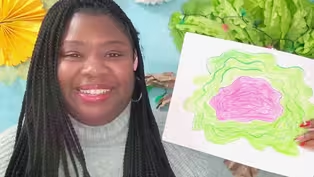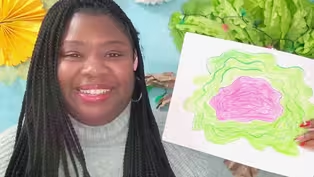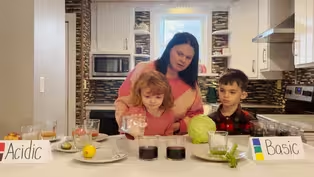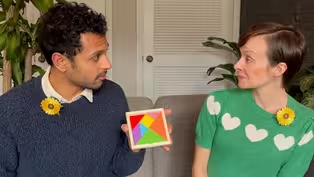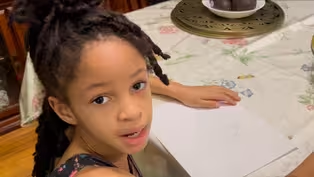
LONG E SOUNDS SPELLED EE AND EA
Clip: 5/19/2023 | 8mVideo has Audio Description, Closed Captions
Anna Scretching-Cole explores long e vowel sounds spelled with ee and ea.
Anna Scretching-Cole explores long e vowel sounds spelled with ee and ea.
See all videos with Audio DescriptionADProblems playing video? | Closed Captioning Feedback
Problems playing video? | Closed Captioning Feedback
Let's Learn is a local public television program presented by THIRTEEN PBS

LONG E SOUNDS SPELLED EE AND EA
Clip: 5/19/2023 | 8mVideo has Audio Description, Closed Captions
Anna Scretching-Cole explores long e vowel sounds spelled with ee and ea.
See all videos with Audio DescriptionADProblems playing video? | Closed Captioning Feedback
How to Watch Let's Learn
Let's Learn is available to stream on pbs.org and the free PBS App, available on iPhone, Apple TV, Android TV, Android smartphones, Amazon Fire TV, Amazon Fire Tablet, Roku, Samsung Smart TV, and Vizio.
Providing Support for PBS.org
Learn Moreabout PBS online sponsorship[upbeat music] [inhales and sighs] - Isn't it great to see flowers blooming when spring starts to come?
The sweet smell of flowers always puts me in a good mood.
Which is actually pretty great because the words see and sweet actually have our sound for today.
Can you guess the sound?
Listen carefully.
See and sweet.
That's right, the sound is long E. But before we get into our long E work, let's get our ears ready with some sounds.
What's gonna happen is we're gonna do some deleting of words.
I'm gonna say a word and I'm gonna ask you to take off a part of the word, leaving only a word behind.
And I wanna see if you can figure out that new word.
Sounds confusing, but it's not.
So for example, if I say the word cardboard.
Now say cardboard without card.
What's the word left?
Well, we had card board.
I took away card, now board is left.
So you would say board.
All right, let's try a few of these.
Ready?
Say butterfly without butter.
That's right, fly.
Say pancake without pan: cake.
Say football without foot: ball.
Say rainbow without rain: bow.
All right, now listen carefully.
I might try to trick you, say toothbrush without brush.
Aha, this time, tooth.
I left the first word.
Okay, last one, say starfish without fish.
That's right, star.
Awesome job.
Today we're going to be working on two ways of spelling the long E sound.
So the long E sound says it's name, or E. Can you repeat that after me: E. The two spellings we're going to work with today are E E for E and E A also for E. Now, there is no trick or rule to know when to use either of these spellings.
The only way you're gonna figure it out is really just through lots of practice and exposure.
So reading lots of books, practicing writing lots of words.
And when people use words that have like that long E sound asking them, how do you spell that word?
Okay.
So today what we're gonna do is we're gonna practice reading some long E words spelled E E and E A.
Let's practice with E E first.
So we're gonna blend through these sounds and we're gonna read the word, okay?
So blend and read with me.
Beep like horn, beep beep.
How about this word?
Let's blend and read together.
Deep, deep.
Good.
This is one of the words that started our lesson.
Let's blend it.
Sweet.
Sweet.
Let's do one more, okay.
Tweet, tweet, like the sound a bird makes.
Tweet tweet!
All right, let's go over to our E A side for a little bit first, okay?
So E A is still going to make that E sound.
Okay, so let's start with this one, ready?
Eat, eat, oh, I'm getting hungry.
How about this next one, let's blend it.
Beat, beat, okay.
So this beat is like the beat of the drum.
[taps hands and hums] beat!
Okay, how about this word?
Heat, heat.
Oh, it's getting hot, heat.
All right, how about this one?
Treat, treat.
Okay, now remember how I told you there's really no trick or rule to know when to use E E versus E A?
Well, that's because some of these words are gonna be homophones where they sound the same, but they're spelt differently.
So let me give you some examples where you can see the same words spelt differently.
Okay, but they sound exactly the same.
So let's look at this first one.
Well we know E E is going to say E. So let's go, meet, meet.
Well come over here and blend this word with me.
We know E A says E. So meat, meat.
Wait a minute, didn't we just say this one was meet?
Meet, meat.
Okay, so in this case, this meet means like when you first see someone, like it's nice to meet you, you shake hands.
This meat is like the meat that you eat like a hamburger meat, okay?
Same thing with, take a look at this last one.
We have cheep, cheep, like a birdie tweet.
Cheep, cheep, cheep, cheep, cheep.
And then we have cheap, cheap, like when something's not expensive or not worth a lot of money, okay?
Cheap.
Excellent job reading these words with me.
All right, now it's your turn to read a few more long E words all by yourself.
It's time for the lightning round.
You're gonna see a whole bunch of words come up on the screen.
Do your best to blend the sounds and read the words.
And remember, our focus sound is that long E spelled either E E or E A.
Ready?
Let's go.
So how did you do?
Did you say: eat, tee, beep, seat, feet, wheat?
If you got all six, right, give yourself a high five.
Time for round two.
A little faster this time.
So how did you do?
Did you say: sweet, tea, treat, eel, neat, peel?
Did you get all six right this time?
Awesome job, friends.
You did a great job today working with the long E sound spelled E E, and E A.
See how many more of those long E words you can see when you read.
Because remember, the more you practice, the more you're gonna know that.
Well, I'm gonna go get me a sweet treat.
Until next time, bye!
Video has Audio Description, Closed Captions
Clip: 6/12/2023 | 7m 31s | Darlene Thomas reads RAINING by Pingping Xu with illustrations by Graca Lima. (7m 31s)
Video has Audio Description, Closed Captions
Clip: 5/19/2023 | 7m 49s | Lia Zuilivia from Studio in a School draws the lines and shapes of a houseplant. (7m 49s)
Video has Audio Description, Closed Captions
Clip: 5/19/2023 | 7m 31s | Darlene Thomas reads RAINING by Pingping Xu with illustrations by Graca Lima. (7m 31s)
Video has Audio Description, Closed Captions
Clip: 5/19/2023 | 7m 59s | Cassondra Easterling and her children use cabbage water to test the acidity of fruit juice (7m 59s)
Video has Audio Description, Closed Captions
Clip: 5/19/2023 | 11m 37s | Diane Sanlatte teaches a song about the four seasons in Spanish. (11m 37s)
USING TANGRAMS TO MAKE FLOWERS AND TREES
Video has Audio Description, Closed Captions
Clip: 5/19/2023 | 9m 57s | Omar Etman and Lily Fincher show how to use tangrams to make flowers and trees. (9m 57s)
ZURI SHOWS HOW TO DRAW A FLOWER!
Video has Audio Description, Closed Captions
Clip: 5/19/2023 | 59s | Zuri shows how to draw a flower. (59s)
Providing Support for PBS.org
Learn Moreabout PBS online sponsorshipSupport for PBS provided by:
Let's Learn is a local public television program presented by THIRTEEN PBS
